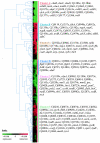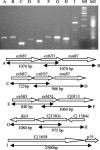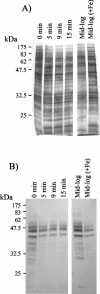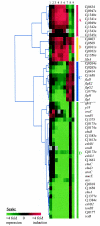Iron acquisition and regulation in Campylobacter jejuni
- PMID: 15231804
- PMCID: PMC438614
- DOI: 10.1128/JB.186.14.4714-4729.2004
Iron acquisition and regulation in Campylobacter jejuni
Abstract
Iron affects the physiology of bacteria in two different ways: as a micronutrient for bacterial growth and as a catalyst for the formation of hydroxyl radicals. In this study, we used DNA microarrays to identify the C. jejuni genes that have their transcript abundance affected by iron availability. The transcript levels of 647 genes were affected after the addition of iron to iron-limited C. jejuni cells. Several classes of affected genes were revealed within 15 min, including immediate-early response genes as well as those specific to iron acquisition and metabolism. In contrast, only 208 genes were differentially expressed during steady-state experiments comparing iron-rich and iron-limited growth conditions. As expected, genes annotated as being involved in either iron acquisition or oxidative stress defense were downregulated during both time course and steady-state experiments, while genes encoding proteins involved in energy metabolism were upregulated. Because the level of protein glycosylation increased with iron limitation, iron may modulate the level of C. jejuni virulence by affecting the degree of protein glycosylation. Since iron homeostasis has been shown to be Fur regulated in C. jejuni, an isogenic fur mutant was used to define the Fur regulon by transcriptome profiling. A total of 53 genes were Fur regulated, including many genes not previously associated with Fur regulation. A putative Fur binding consensus sequence was identified in the promoter region of most iron-repressed and Fur-regulated genes. Interestingly, a fur mutant was found to be significantly affected in its ability to colonize the gastrointestinal tract of chicks, highlighting the importance of iron homeostasis in vivo. Directed mutagenesis of other genes identified by the microarray analyses allowed the characterization of the ferric enterobactin receptor, previously named CfrA. Chick colonization assays indicated that mutants defective in enterobactin-mediated iron acquisition were unable to colonize the gastrointestinal tract. In addition, a mutation in a receptor (Cj0178) for an uncharacterized iron source also resulted in reduced colonization potential. Overall, this work documents the complex response of C. jejuni to iron availability, describes the genetic network between the Fur and iron regulons, and provides insight regarding the role of iron in C. jejuni colonization in vivo.
Copyright 2004 American Society for Microbiology
Figures








Similar articles
-
Characterization of the oxidative stress stimulon and PerR regulon of Campylobacter jejuni.BMC Genomics. 2009 Oct 18;10:481. doi: 10.1186/1471-2164-10-481. BMC Genomics. 2009. PMID: 19835633 Free PMC article.
-
The Campylobacter jejuni dccRS two-component system is required for optimal in vivo colonization but is dispensable for in vitro growth.Mol Microbiol. 2004 Dec;54(5):1269-86. doi: 10.1111/j.1365-2958.2004.04371.x. Mol Microbiol. 2004. PMID: 15554967
-
Campylobacter jejuni gene expression in response to iron limitation and the role of Fur.Microbiology (Reading). 2005 Jan;151(Pt 1):243-257. doi: 10.1099/mic.0.27412-0. Microbiology (Reading). 2005. PMID: 15632442
-
How we learnt about iron acquisition in Pseudomonas aeruginosa: a series of very fortunate events.Biometals. 2007 Jun;20(3-4):587-601. doi: 10.1007/s10534-006-9067-2. Epub 2006 Dec 22. Biometals. 2007. PMID: 17186376 Review.
-
Polyphosphate and associated enzymes as global regulators of stress response and virulence in Campylobacter jejuni.World J Gastroenterol. 2016 Sep 7;22(33):7402-14. doi: 10.3748/wjg.v22.i33.7402. World J Gastroenterol. 2016. PMID: 27672264 Free PMC article. Review.
Cited by
-
The Campylobacter jejuni Dps homologue is important for in vitro biofilm formation and cecal colonization of poultry and may serve as a protective antigen for vaccination.Clin Vaccine Immunol. 2012 Sep;19(9):1426-31. doi: 10.1128/CVI.00151-12. Epub 2012 Jul 11. Clin Vaccine Immunol. 2012. PMID: 22787197 Free PMC article.
-
Ferric uptake regulator and its role in the pathogenesis of nontypeable Haemophilus influenzae.Infect Immun. 2013 Apr;81(4):1221-33. doi: 10.1128/IAI.01227-12. Epub 2013 Feb 4. Infect Immun. 2013. PMID: 23381990 Free PMC article.
-
Campylobacter jejuni CsrA complements an Escherichia coli csrA mutation for the regulation of biofilm formation, motility and cellular morphology but not glycogen accumulation.BMC Microbiol. 2012 Oct 11;12:233. doi: 10.1186/1471-2180-12-233. BMC Microbiol. 2012. PMID: 23051923 Free PMC article.
-
Characterization of the oxidative stress stimulon and PerR regulon of Campylobacter jejuni.BMC Genomics. 2009 Oct 18;10:481. doi: 10.1186/1471-2164-10-481. BMC Genomics. 2009. PMID: 19835633 Free PMC article.
-
Investigation of the human pathogen Acinetobacter baumannii under iron limiting conditions.BMC Genomics. 2011 Feb 23;12:126. doi: 10.1186/1471-2164-12-126. BMC Genomics. 2011. PMID: 21342532 Free PMC article.
References
-
- Andrews, S. C., A. K. Robinson, and F. Rodriguez-Quinones. 2003. Bacterial iron homeostasis. FEMS Microbiol. Rev. 27:215-237. - PubMed
Publication types
MeSH terms
Substances
Grants and funding
LinkOut - more resources
Full Text Sources
Other Literature Sources
Medical
Molecular Biology Databases
Research Materials

